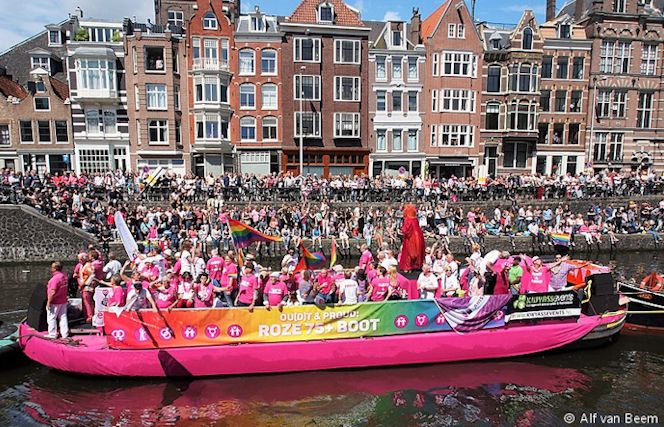Gay Pride Parades
Homosexuality used to be illegal in the United States. On June 28th, 1969, The Stonewall Inn was raided by the police yet again and all the patrons were harassed. The LGBT+ visitors were tired of the harassment and violence and they fought back against the police. Exactly a year later, to look back on this event, the first Gay Pride Parade was held with between 5,000 to 10,000 participants. Pride was a party and a protest.
Different Pride events evolved all over the world, under all kinds of names like Gay Pride Parade, Pride Parade, Christopher Street Day, Mardi Gras, LGBT Pride, and Pink Saturday.
The Netherlands has two big Pride events: Pink Saturday and Pride Amsterdam, which ends with the Canal Parade: a colourful train of decorated boats and LGBT+ people. The first Pink Saturday happened in Roermond in 1979 and happens in a different city every year on the last Saturday of June. Amsterdam Pride is on the first Saturday of August.

In some countries, Pride is mostly a party. Pride Amsterdam attracts half a million visitors. The biggest Pride Parades happen in Brazil: Rio de Janeiro (2 million visitors) and Sao Paulo (3.2 million visitors).
In other places, Pride is less of a celebration. In Russia, the parades are usually not allowed and people who still join them are violently stopped by the police and far-right protesters. Parades in Turkey also often end in violence. Coming out
Coming out
Homosexuality was illegal in the United States. On October 11th 1987, fifty thousand people gathered in Washington to protest the fact that sodomy (an old word for homosexual acts) was still against the law in America. After this, October 11th of every year became a day to celebrate people coming out. Coming Out Day also spread to other countries, like Australia, New Zealand, Canada, Great Britain, Croatia, Germany, Poland, and the Netherlands.
In the Netherlands, Coming Out Day is organised by COC Nederland. Most of the country joins in by putting up rainbow flags and painting pedestrian crossings in rainbow colours, as a sign of acceptance and diversity.
Dozens of local governments, municipalities, schools, sports clubs, companies, police stations, and ministries organise activities like lectures or festival. The message of Coming Out Day is that everyone should be able to be themselves every day.

